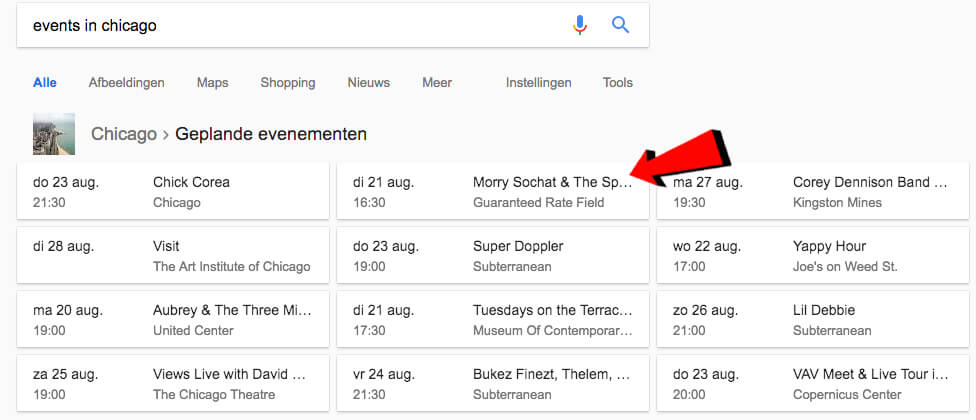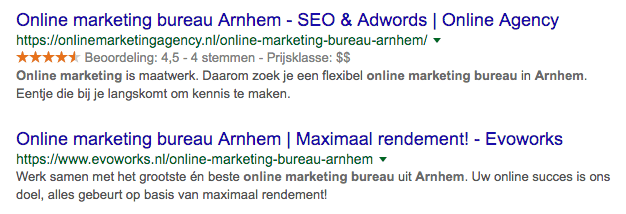Menu
Table of contents
For example, you can let Google know that the reviews on your website are actually reviews.
That will look like this:

In addition to review stars and price range, there are other forms of structured data.
So what types of structured data are there and what do they look like?
For every industry, there is some form of structured data which adds to your online presence.
From baker to webshop (or a webshop with baked goods) and from lawyer to wholesaler.
To give you an idea of those forms, I'll cover them all briefly (briefly).
Breadcrumbs
Breadcrumbs, also known as breadcrumb trail, is the marking of content for the purpose of making part of your website's URL structure clear to Google.
This has the advantage that Google understands your website better and faster, and thus your website can be indexed better and faster.
A useful side effect of adding breadcrumbs is that your search results will look different.
So something like this:

A competitor of Eijerkamp does not have breadcrumbs and it looks like this:

Do you see the difference?
Eijerkamp's search result looks just a little better.
Sitelinks
Sitelinks are links below the meta description in organic search results that make it easier for the visitor to visit pages other than the home page immediately.
That sounds exciting, but looks like this:

The advantage of this is that potential customers can go straight to the right page within your website.
They don't have to search, don't click around but land right away.
This saves visitors time and provides more convenience.
So incredibly nice for your visitors.
But having sitelinks has another big advantage.
This is because you claim more space in the search results; you stand out a little more when your competitors don't have them.
Products
If you sell products on your website, this form of structured data is a must-have.
In fact, you can show in the search results the price of the product and whether the product is still in stock:

That may be decisive for a potential customer.
But pay attention!
Failing to deliver on that promise and not having your product in stock can actually be a conversion killer.
Recipes
Structured data for recipes is the form of structured data when you share the preparation of your grandmother's apple pie.
Or when you reveal to your visitors the secret recipe for that special McDonald's sauce.
In fact, with structured data for recipes, you can immediately show how long it takes to make something and how many calories are in a dish.
This can avoid the disappointment in people who have little time or those who are on a diet.

Because you offer a piece of information right away, it can persuade the searcher to click on your website this.
And that, of course, is what you want.
Events
Highlighting the content surrounding your event can result in two benefits:
1: events can be shown below your search results ...
So thus:

And 2: Events can be added above all search results.
That in turn looks like this:

Benefit 1 allows you to claim more space in search results and lets people know immediately what events you all offer.
Benefit 2 mainly leads to people who were not directly looking for your organization still getting to see your events.
Local company
If you are a baker around the corner or another "small" business owner, you should use the structured data for local businesses.
Yes, you read that correctly: must.
I never actually say that.
But you obviously want to be found as a baker when someone searches on "baker in Duiven.
But you also want to be found if someone in Duiven just googles "baker".
And then to be found well you have to use the structured data for local businesses.
Combined with a Google My Business page, it maximizes structured data for local businesses. Click here to go to my blog for applying for a Google My Business page.
Reviews
Ah, there's my favorite form of structured data: the review stars.
Review stars are an incredibly powerful tool for persuading someone to click on your organization.
With a good rating, you prove that you are doing a good job.
In addition, the stars make you stand out more.
See:

Which of the two do you think stands out the most?
The top one, of course, because that's us!
But there is a caveat to using review stars.
In fact, the stars are incredibly easy to fake.
In fact, Google simply accepts it when you pass on a five-star rating a hundred times.
So never rely blindly on the stars (but that doesn't mean you can't use them).
Because they are so easy to fake, they may not earn you a better position in Google, but you do stand out more, which means your website's click-through rate can be higher than that of your competitors.
And you and Google both like that.
Price Range
If you've been paying close attention to the review stars, you've already seen this one go by!

Next to the review stars is a price range indicating how expensive (or cheap) your organization is.
I personally think it's a nice addition because you can give the visitor an immediate impression.
You create some kind of expectation before visitors land on your website.
If you have an organization that focuses on the more expensive segment I would omit the price range.
Your target audience then often doesn't care about pennies anyway.
But are you a prize fighter?
If so, be sure to add it!
But what exactly does $$ mean?
This is different for everyone.
What is very expensive for some may be a pittance for others.
So also take the price range with a grain of salt.
Review
Review structured data is very similar to review structured data.
This is because you also see the stars, but with the review it is about 1 number and you can show who the review is from.
That then looks like this:

What I think is cool about this is that you don't just see the organization.
Because by adding a name you make it very personal.
So if you have your own blog, or give your opinion on something, I would definitely use the review structured data!
Now that you know the different markings, it's high time to explain how to add the markings yourself!
How do you add structured data to your website?
To be perfectly honest ... adding structured data should really be left to a professional.
And I'm talking about an online marketer with technical knowledge or a website builder.
Nevertheless, you can add structured data yourself in the following two ways:
- You can manually add a piece of code (highly discouraged!)
- You can install a plugin (on WordPress websites)
If you want to add the structured data yourself then I would install a plugin so you can't (in principle) make mistakes that cause your website to fail.
On the other hand, if you start making changes in the code of your Web site, that can happen.
Don't.
Personally, I use the WordPress plugin called Testimonials Showcase.
That ensures that the price range and review stars are listed with my search results.
I didn't have to make any changes to the code and just added some testimonials to my website.
Those testimonials look like this:

Will you add the structured data yourself or will you direct the website builder or online marketer to add the structured data?
Then I recommend you start reading the following websites:
- https://schema.org/
- https://developers.google.com/search/docs/guides/intro-structured-data
- https://moz.com/blog/structured-data-for-seo-1
How can you best use structured data?
In fact, I always advise you to put in structured data.
Having structured data just has tremendous benefits:
- You grab more space in Google.
- You stand out more.
- You exude authority.
- You will be found better.
Now I hear you thinking: which one should I deploy for my organization?
First, you need to carefully consider the purpose of your website.
Are you selling something on your website?
Then use the products structured data.
Are you offering a service?
Then go for the review stars.
If your website has multiple goals, then it is important to know what the goal for each page is.
Do you explain how to make poffertjes on that one page?
Then provide recipe structured data.
On another page, do you tell something about the poffertjes festival you are organizing?
But there then use the events structured data.
I could go on and on, but I think you understand!

Source: Wolfgangdigital
What is the benefit of structured data on spoken search?
I hope by now you are convinced of the power of structured data.
If you haven't already: structured data has another terrible advantage.
Because you make the content understandable to the search engines, the search engines can also read this content when you do a spoken search.
And that's the future.
Case in point: I ask Google: Hey Google, what's the nearest bakery?
Google reads your structured data and sees that your bakery is the closest.
Google responds: The nearest bakery is Baker X.
Another example: I ask Google what events are all in Arnhem tomorrow.
Yes, you guessed it: Google reads your structured data and also gives me your event that is then tomorrow in Arnhem as a result.
At the beginning of 2018, Google already indicated that about 20% of all searches were done by voice message.
This percentage is only going to increase in the coming years, so I recommend that you start using structured data as soon as possible and get ahead of your competitors.
Are you not succeeding?
Just click the button below and I'll do it for you!











Written by: Daniel Kuipers
Daniel is the founder of Online Marketing Agency. He constantly scours the Internet for the latest gadgets and tactics and blogs about them in understandable language. Well, sometimes.